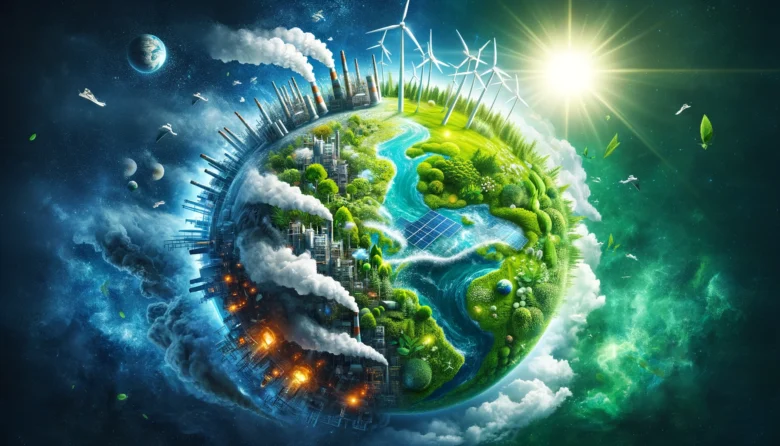Climate change is one of the biggest challenges facing the planet today. With rising global temperatures and the increasing frequency of catastrophic weather events, the need for effective solutions is more urgent than ever. The positive news is that people are coming up with creative solutions. Green technology is a field focused on creating solutions that benefit the environment. It offers us numerous tools to combat climate change, reduce our carbon footprint, and build a better future. This article explores some of the most promising green technology solutions that are already making the world a better place.
Understanding Green Technology
“Green technology” encompasses a wide range of new technologies designed to reduce or eliminate the damage humanity has inflicted on the environment. This includes everything from large-scale renewable energy projects to smart gadgets that help us save energy at home. Sustainability is the core concept behind green technology. It means meeting our current needs without making it harder for future generations to meet theirs. By focusing on sustainable energy, sensible resource management, and waste reduction, these technologies offer a clear path to directly addressing climate change.
The Benefits of Renewable Energy
A key component of green technology is the transition from fossil fuels to renewable energy. Solar, wind, and hydropower are becoming increasingly cost-effective, making them promising ways to power the world. Solar panels, for example, convert sunlight directly into electricity without emitting harmful gases. Wind turbines harness the power of the wind to generate clean energy, while hydroelectric dams harness the flow of water. Switching to these renewable energy sources will significantly reduce greenhouse gas emissions that contribute to climate change.
Making Every Watt Count with Energy Efficiency
Having access to clean energy is not the only challenge; we also need to utilize it more efficiently. Energy-saving technologies aim to reduce energy consumption in our homes, businesses, and industries. For example, LED lights consume significantly less electricity than conventional incandescent bulbs, and smart thermostats that control heating and cooling to save energy are two examples of these new ideas. Green building materials and designs help improve the thermal insulation of buildings and reduce the energy needed to maintain a comfortable temperature. Such action further reduces our overall energy consumption.
Green Transportation Reinvented
Greenhouse gas emissions come from many different sectors, but transportation is one of the most significant. Green technology is transforming the way we travel, offering us greener and more efficient options. Electric vehicles (EVs) are leading this transformation. They emit zero emissions and are becoming increasingly accessible to the general public. Improvements in public transportation, including electric buses and high-speed rail, help us reduce our reliance on fossil fuels, not just passenger cars. These new concepts are crucial for creating cleaner cities and more sustainable transportation networks.
Controlling CO₂ Emissions in a Timely Way
Even as we transition to cleaner energy sources, we must take action to address the CO₂ emissions already in the air. Carbon capture and storage (CCS) systems are designed to prevent CO₂ emissions from power plants and factories from entering the atmosphere. Once captured, the CO₂ is transferred and stored in deep geological formations. CCS is still a nascent field, but it could be a crucial tool in our fight against climate change, especially in sectors that are difficult to decarbonize completely.
Cultivating a Greener Future with Smart Agriculture
Agriculture has a significant impact on the environment, but green technologies are making it more sustainable. “Smart agriculture,” or “agtech,” uses tools like GPS, sensors, and drones to maximize crop yields with minimal inputs. Precision farming, for example, allows farmers to apply water and fertilizer only where needed, reducing waste and runoff. Vertical farming and hydroponics are two other emerging methods for growing crops in controlled environments using less water and land. These methods can contribute to improving the sustainability of our food system.
Turning Waste into a Resource
Another crucial component of a sustainable society is sound waste management. Green technology offers new ways to reduce, reuse, and recycle waste. Waste-to-energy plants can convert non-recyclable waste into electricity, while advanced recycling technologies can process a wider range of materials. Composting and anaerobic digestion are two other methods for converting organic waste into useful products such as biogas and fertilizers. By changing the way we think about waste, we can conserve resources, reduce landfills, and lessen our environmental impact.
Pioneering the Future
Green technology offers a comprehensive and promising solution to climate change. By using renewable energy, improving energy efficiency, and innovating in areas such as transportation and agriculture, we can make the planet more sustainable and resilient. The problem is enormous, but solutions are within reach. Supporting and investing in this green technology is not only beneficial for the environment but also for everyone’s future.
FAQs
1. What is the best green technology for combating climate change?
There are many potential technologies, but renewable energy sources like solar and wind are considered the most important. They are rapidly replacing fossil fuels, the largest source of greenhouse gas emissions. Their prices have fallen significantly, making them widely available.
2. How can people promote the adoption of green technology?
People can have a significant impact on the world by using green technology in their daily lives. This could mean switching to LED lighting, using a smart thermostat, purchasing energy-efficient appliances, considering an electric car as their next vehicle, or installing solar panels on their home.
3. Is using green technology expensive?
Some green technologies may have higher initial costs than standard technologies. However, in the long run, many green technologies, such as solar panels and electric vehicles, can save money by reducing energy and fuel costs. Their prices are also falling thanks to government incentives and price reductions.
4. Can green technology completely solve the climate crisis?
Green technology is a very useful and important tool, but it is not a panacea. Addressing climate change requires new technologies, policy changes, international cooperation, and individual action. Technology provides us with the tools, but we must work together to ensure they work effectively.
5. How can governments promote green technology?
Governments are crucial because they set the rules that make green technology possible. This includes funding research and development, providing tax breaks and subsidies for green products, setting renewable energy standards, and putting a price on carbon emissions to make fossil fuels less attractive.




